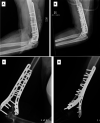Complications and Survivorship of Distal Humeral Allograft Reconstruction After Tumor Resection: Literature Review and Case Series
- PMID: 33591127
- PMCID: PMC7886443
- DOI: 10.5435/JAAOSGlobal-D-20-00256
Complications and Survivorship of Distal Humeral Allograft Reconstruction After Tumor Resection: Literature Review and Case Series
Abstract
Background: Primary bone sarcomas of the proximal humerus represent most bone sarcomas in the upper extremity. However, limited literature exists on the survival and complications of distal humeral allograft reconstruction because of the relative rarity of disease at the distal end.
Methods: We performed a literature review in PubMed and EMBASE using the terms"Humerus,""Distal," "Allograft," and "Reconstruction" to include all the patients with distal humeral reconstructions. In addition, a retrospective review of all patients who underwent distal humerus tumor resection and allograft reconstruction at our tertiary care center over a 23-year period was performed.
Results: Fourteen patients in four different case series have been reported previously with an allograft survival rate of 86%. Thirty-six percent of patients experienced complications, most commonly nonunion (3) and allograft subluxation (2). In a retrospective review at our institution, six met the inclusion criteria and were found to have similar complications.
Conclusion: Based on our experience and the review of the literature, nonunions are the most frequent complication and junctional fractures are the most common cause of revision of allografts in this location. Larger sample studies are required to identify potential correctable predictors of these complications. In addition, complications should be correlated with functional outcome data.
Copyright © 2021 The Authors. Published by Wolters Kluwer Health, Inc. on behalf of the American Academy of Orthopaedic Surgeons.
Figures
Similar articles
-
Allograft reconstruction of the humerus: Complications and revision surgery.J Surg Oncol. 2019 Mar;119(3):329-335. doi: 10.1002/jso.25309. Epub 2018 Dec 5. J Surg Oncol. 2019. PMID: 30517776
-
Do Massive Allograft Reconstructions for Tumors of the Femur and Tibia Survive 10 or More Years after Implantation?Clin Orthop Relat Res. 2020 Mar;478(3):517-524. doi: 10.1097/CORR.0000000000000806. Clin Orthop Relat Res. 2020. PMID: 32168064 Free PMC article.
-
Do Early Results of Proximal Humeral Allograft-Prosthetic Composite Reconstructions Persist at 5-year Followup?Clin Orthop Relat Res. 2019 Apr;477(4):758-765. doi: 10.1097/CORR.0000000000000354. Clin Orthop Relat Res. 2019. PMID: 30811366 Free PMC article.
-
Hemicortical resection and inlay allograft reconstruction for primary bone tumors: a retrospective evaluation in the Netherlands and review of the literature.J Bone Joint Surg Am. 2015 May 6;97(9):738-50. doi: 10.2106/JBJS.N.00948. J Bone Joint Surg Am. 2015. PMID: 25948521 Review.
-
Limb Salvage and Reconstruction Options in Osteosarcoma.Adv Exp Med Biol. 2020;1257:13-29. doi: 10.1007/978-3-030-43032-0_2. Adv Exp Med Biol. 2020. PMID: 32483727 Review.
Cited by
-
Early functional and therapeutic effect of reversed tumour shoulder prosthesis reconstruction after proximal humerus tumour resection.Front Surg. 2022 Sep 23;9:987161. doi: 10.3389/fsurg.2022.987161. eCollection 2022. Front Surg. 2022. PMID: 36211281 Free PMC article.
-
Graft Infections in Biologic Reconstructions in the Oncologic Setting: A Systematic Review of the Literature.J Clin Med. 2024 Aug 8;13(16):4656. doi: 10.3390/jcm13164656. J Clin Med. 2024. PMID: 39200798 Free PMC article. Review.
-
Resection for malignant tumors in the elbow and individualized reconstruction under assistance of 3D printing technology: A case report.Medicine (Baltimore). 2023 Sep 1;102(35):e34854. doi: 10.1097/MD.0000000000034854. Medicine (Baltimore). 2023. PMID: 37657014 Free PMC article.
-
Outcomes of management of primary benign aggressive or malignant bone tumors around the elbow by limb-salvage surgery.J Exp Orthop. 2023 Oct 23;10(1):105. doi: 10.1186/s40634-023-00675-z. J Exp Orthop. 2023. PMID: 37870629 Free PMC article.
-
Three-dimensional printed bone cement prostheses can be used to treat bone defects in the distal humerus.JSES Rev Rep Tech. 2022 Jul 2;2(4):584-591. doi: 10.1016/j.xrrt.2022.06.004. eCollection 2022 Nov. JSES Rev Rep Tech. 2022. PMID: 37588462 Free PMC article. No abstract available.
References
-
- Capanna R, Muratori F, Campo FR, et al. : Modular megaprosthesis reconstruction for oncological and non-oncological resection of the elbow joint. Injury 2016;47(suppl 4):S78-S83. - PubMed
-
- Picci P, Manfrini M, Fabbri N, Gambarotti M, Vanel D, eds: Atlas of Musculoskeletal Tumors and Tumorlike Lesions. Cham, Springer International Publishing, 2014.
-
- Allieu Y, Marck G, Chammas M, Desbonnet P, Raynaud J-P: Total elbow joint allograft for long term posttraumatic osteoarticular loss. Follow-up results at twelve years. Rev Chir Orthop Reparatrice Appar Mot 2004;90:319-328. - PubMed
-
- Clohisy DR, Mankin HJ: Osteoarticular allografts for reconstruction after resection of a musculoskeletal tumor in the proximal end of the tibia. J Bone Joint Surg Am 1994;76:549-554. - PubMed
-
- Dean GS, Holliger EH, Urbaniak JR: Elbow allograft for reconstruction of the elbow with massive bone loss. Long term results. Clin Orthop Relat Res 1997:12-22. - PubMed
Publication types
MeSH terms
LinkOut - more resources
Full Text Sources
Other Literature Sources
Miscellaneous


